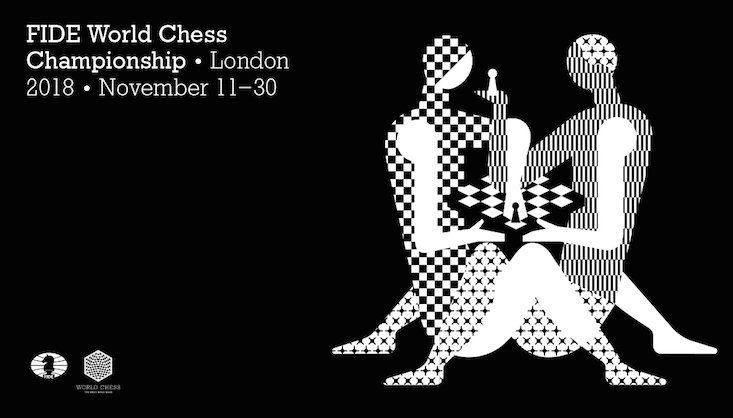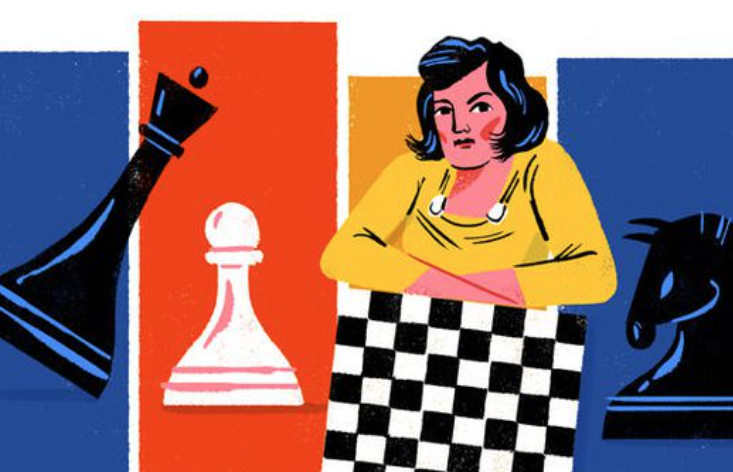The real-life Queen’s Gambit: how Georgia’s Nona Gaprindashvili conquered the chess world
You’ve probably already heard of Netflix series, The Queen’s Gambit, which follows the life of American chess prodigy Beth Harmon in her quest to take on the world’s top Grandmasters, all while battling her inner demons.
When Harmon finally faces the Soviet heavyweights in Moscow for the first time, the camera pans briefly to a female Soviet chess player, Nona Gaprindashvili. While Harmon’s story is fictional, Gaprindashvili is a real chess player from Georgia who became the Women’s World Chess Champion five times. In the show, Gaprindashvili is introduced by the commentator as “a female world champion, who has never faced men”, something that surprised the real Gaprindashvili, who was no stranger to playing chess against male opponents.
From Estonian Keres and Serbian Gligorić to American Tarjan and Latvian Tal, “I played against many great Grandmasters,” says the 79-year old, who became the world’s first female Grandmaster — the highest title awarded to chess players — at the age of 37. Today, she is talking via video call from her Tbilisi home after watching her favourite snooker player, Judd Trump, enter the semi-finals of the Northern Ireland Open. In the background is an open chess board. “I had many notable matches against them, and I received many acknowledgements from them for those matches,” she continues. “So, it’s completely untrue. It’s not a big emotional factor to be honest, but it’s dishonouring to have misinformation spread about someone’s achievements.”
Batumi
1954
Gaprindashvili was born in the Georgian city of Zugdidi, a stone’s throw away from the Black Sea coast, in 1941. She grew up with her parents, four older brothers, and a younger brother. “We were a very active family,” she describes. “We played everything from football to volleyball and table tennis to billiards.” Tournaments held in their small family garden would attract the entire neighbourhood, she said.
From a young age, Gaprindashvili was not afraid to set her sights on winning. And, of all the games she played, chess gripped her the most. Learning from her older brothers, she was intent on beating her siblings, as well as all of the other boys in the neighbourhood. “I was, and I still am, very competitive. This [drive] is what has helped me most in chess.”
In 1954, at the age of 12, she found herself competing for the Zugdidi city team at the Georgian National Championships, hosted in the seaside town of Batumi — despite not applying to take part. When the all-male Zugdidi team heard about a girl in town who was a skilled chess player, they invited her to play in place of her brother, “who was prepping for university and had no time to compete.”
Gaprindashvili in 1963. Image: Jack de Nijs/Anefo/Wikimedia Commons under a CC licence
It was in Batumi that young Gaprindashvili was discovered by renowned Georgian chess coach, Vakhtang Karseladze, who convinced her parents to move to Tbilisi, so she could train at one of the capital’s prestigious chess schools. Two years later, Gaprindashvili went on to win the Women’s Georgian Chess Championship title in 1956, (followed by three more victories in 1959, 1960, and 1961).
While Georgia had no World Chess Champions yet, chess tournaments were attracting masses in every city. “Everyone loved chess. It was a game that united us all. On lunch breaks, you would often see people playing chess against each other.”
Moscow
1962
At the age of 21, Gaprindashvili won her first World Women’s Chess Championship title by defeating twice World Women’s Champion Elisaveta Bykova from Russia with a landslide score. The win was a great victory for the small nation of Georgia. Gaprindashvili wore a victory garland on her train journey back home, and her Georgian fans flocked to stations across the country to watch her train pull in.
Her victory in Moscow attracted worldwide attention, and a year after her first title win, Gaprindashvili was invited to an exclusive chess tournament in Hastings, England, attended by the world’s top players: from Capablanca and Alekhine to Spassky and Botvinnik. As the second woman to ever compete in the tournament, and the first to win top spot, Gaprindashvili was no longer praised for her gender, alone. She had “the chess world in something of a checkmate,” as one Daily Mirror article put it.
After being invited back to Hastings in 1965 — this time to take part in the main tournament — she played against the likes of Mikhail Tal. Gaprindashvili eventually won fifth place, beating all of the British players and drawing with chess heavyweight Keres. Her win put her in the same ranking as three-time World Chess Champion Botvinnik when he first came to Hastings in 1934-35.
Lone Pine
1977
Known for her aggressive style, Gaprindashvili was especially praised for her tactical skill and her keen eye for a good combination of moves. In her 1974 match against German master Rudolf Servaty in Dusseldorf, she sacrificed both her rooks — major pieces on the board — to clinch a checkmate and force her opponent to resign. But Gaprindashvili’s favourite matches are from the 1977 Lone Pine tournament, a prestigious event in the chess calendar.
As the only woman invited, in a year when the entry requirements were raised to make the contest more difficult to enter, she won joint first place with Grandmasters Argentinian Panno, Russian Balashov, and Serbian Sahovic.
“I am still amazed by the quality of the matches I played,” Gaprindashvili says, “because those were not prepared at home — the moves were spontaneous.” Gaprindashvili received notable praise for her “fine end-game technique”, as one New York Times article described it, in the match against American Grandmaster Tarjan, in which she sacrificed a pawn to secure a win.
It was her performance at these tournaments, among other achievements, that earned her the title of Grandmaster in 1978, the first woman to do so at the time.
But being a top chess player did not come without difficulties.
Tbilisi
1978
Often, the pressure of performing for a nation outweighed the intensity of chess itself. She recalls defending her World Women’s title in 1969 against Russian (later Israeli) player Alla Kushnir, who challenged the Woman’s Champion three times. With two matches held in Tbilisi and two in Moscow, Gaprindashvili won the games in Russia, but lost her matches on home turf.
“I think that the loss was greatly associated with the emotions that your direct environment puts onto the game,” Gaprindashvili says. “I remember when I got back home to Georgia, the first thing people would ask [sometimes, without greeting me], was: ‘why did I win with such a small points difference?’”
Gaprindashvili (left) vs. Corrie Vreeken-Bouwman of The Netherlands. Image: Harry Pot/Anefo/Wikimedia Commons under a CC licence.
As The Queen’s Gambit shows through Beth Harmon’s struggle with drugs and alcohol, the pressures of professional chess can have harmful consequences. Gaprindashvili warns that talent is not enough: “You have to be psychologically and physically strong, and have a drive for excellence.”
For Gaprindashvili, it was vital to balance chess with other activities. “When I felt stressed, I would switch to a different sport, listen to music, or read — I love reading,” she says. Luckily, finding a balance was a skill that came almost as easily as chess itself. “I’m 80 years old right now, I played so many chess matches, and I can’t even recall one time that I had problems sleeping and there was no situation where I would need anti-depressants or sleeping aid in any way,” she says. “It’s something that comes natural.”
But ultimately, what kept Gaprindashvili motivated was her love for the beauty of the game, rather than chasing the wins. “I value even the losses,” she says.
Bad Liebenzell
1995
Gaprindashvili lost her title in 1978 to another Georgian, 17-year-old Maia Chiburdanidze, who held it for another 13 years and remained the youngest World Chess Champion until 2010. The match marked a new chapter in Georgian chess history. No longer was it just about Gaprindashvili: more Georgian women were rising among the highest ranks of international tournaments.
Four of the finals at the World Women’s Championships between 1962 and 1991 were Georgians against Georgians (1975, 1978, 1981 and 1988) — namely Gaprindashvili and Chiburdanidze alongside Nana Alexandria and Nana Ioseliani. Commentators called them druzhina, a combat-unit. Even after losing her Women’s Champion title, Gaprindashvili went on to win the World Senior Chess Championship in 1995: this time representing Georgia, not the USSR.
How could a small nation like Georgia maintain such a winning streak for so long? Gaprindashvili jokes that the secret is “sunny weather and great wine”.
Since the 12th century, it has been traditional for Georgian brides to receive a chess set and a copy of Shota Rustaveli’s poetry as a wedding gift
But the answer may actually be rooted in history. Since the 12th century, it has been traditional for Georgian brides to receive a chess set and a copy of Shota Rustaveli’s poetry as a wedding gift. Gaprindashvili herself received a valuable chess set as a gift on becoming women’s champion.
The story of Georgia’s renowned female players is now the subject of the film, Glory to the Queen, which premiered in the beginning of September and was the audience award winner at the Free Zone Festival in Serbia.
Bucharest
2019
The directors of Glory to the Queen, Tatia Skhirtladze and Anna Khazaradze, say that Gaprindashvili stood out among her peers. Skhirtladze describes her as confident, strong, and lively: “Nona is kind of unstoppable. There’s no chance you’re not under her influence.”
“While others were nervous and preparing [for their games], she would watch football the nights before the tournaments,” Khazaradze adds. And, of the four women who made up Georgia’s female chess druzhina, Gaprindashvili is the only one who is still participating in tournaments.
More than 50 years since her first title win, Gaprindashvili’s legacy continues. The six-time World Women’s Senior Chess Champion — most recently last year in Bucharest — has the main Tbilisi Chess Palace named after her. There is even a dedicated Nona Gaprindashvili Cup, awarded by FIDE, the international chess organisation. The cup is unique in that it is awarded to the country with the highest combined total points across both male and female players.
Georgian women remain strongly represented among top chess players today, with Nana Dzagnidze — named after Georgian chess legend Nana Alexandria — ranked ninth among women globally. She recently won a crucial tournament in Lausanne, which could mean a step closer to challenging the Women’s Champion in 2022.
Meanwhile, Gaprindashvili hopes that shows like The Queen’s Gambit will continue to raise chess’ profile. “I hope the series will bring more attention and interest in chess, just as my first victories did back in the day,” she says. “Most importantly, for anyone just getting started, it is crucial to dedicate yourself as much as you can and to not back down when you face difficulties as this is a complex game. It requires a lot of attention.”
For now, the only thing to stop Gaprindashvili competing has been the pandemic. When it is over, she plans to resume tournaments once again.
“After all, chess is what fills my life with energy.”


